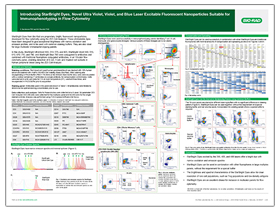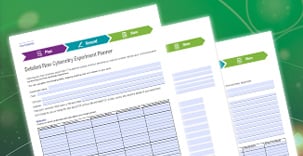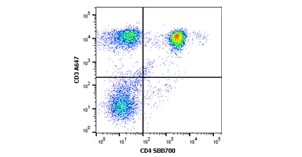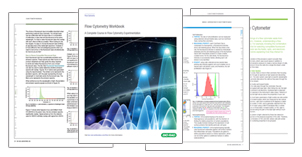
StarBright Dyes
Build the Best Panels with the Brightest and Biggest Range of Dyes
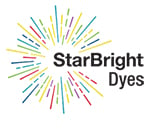 StarBright™ Dyes have been designed to be stable with superior brightness, narrow excitation and emission characteristics, and the flexibility to be included in new and existing experiments. Improved resolution of specific cell populations and minimized spillover and spreading allow you to build bigger, better panels with ease. Conjugated to highly cited immunology antibodies, StarBright Dyes are a great addition to Bio-Rad’s range of fluorescent dyes available for ultraviolet, violet, blue, red, and yellow lasers suitable for use on all cell sorters, cell analyzers, and spectral instruments.
StarBright™ Dyes have been designed to be stable with superior brightness, narrow excitation and emission characteristics, and the flexibility to be included in new and existing experiments. Improved resolution of specific cell populations and minimized spillover and spreading allow you to build bigger, better panels with ease. Conjugated to highly cited immunology antibodies, StarBright Dyes are a great addition to Bio-Rad’s range of fluorescent dyes available for ultraviolet, violet, blue, red, and yellow lasers suitable for use on all cell sorters, cell analyzers, and spectral instruments.

Benefits of StarBright Dyes
 Bright
Bright
 Narrow excitation and emission
Narrow excitation and emission
 Flexible to work in all buffers
Flexible to work in all buffers
 Compatible with all instruments and reagents
Compatible with all instruments and reagents
 Consistent staining
Consistent staining
 On key immunophenotyping targets
On key immunophenotyping targets


StarBright Dyes Range
Bio-Rad has launched multiple StarBright Dyes excitable by the ultraviolet, violet, blue, yellow, green, and now red lasers on a range of human and mouse markers and streptavidin.
- StarBright UltraViolet Dyes
- StarBright Violet Dyes
- StarBright Blue Dyes
- StarBright Yellow Dyes
- StarBright Red Dyes
- StarBright Dye Sample Sizes


StarBright Dye Resources
At Bio-Rad, we provide a comprehensive range of useful antibody resources to support your research and experiments.
- StarBright Dyes Conjugated Antibodies Inquiry Form
- Frequently Asked Questions
- Posters
- Technical Note: Benefits of Using StarBright Dyes
- Technical Note: Incorporating StarBright Dye–Conjugated Antibodies on the ZE5 Cell Analyzer

New, Bright, Fluorescent Nanoparticles Developed for Flow Cytometry
StarBright Dyes are new, proprietary fluorescent nanoparticles conjugated to Bio-Rad's highly validated antibodies. This video demonstrates StarBright Dyes’ exceptional brightness, narrow excitation and emission, and stability with high lot-to-lot reproducibility. You will also discover how easily they can fit into your flow cytometry experiments and how they can be used in immunophenotyping panels to obtain improved results compared to conventional dyes.
Benefits of StarBright Dyes
Exceptional Brightness
Designed to be as bright, or brighter than competitor dyes. The exceptional brightness of StarBright Dyes allows detection of rare and low antigen density populations with excellent separation of positive from negative populations.
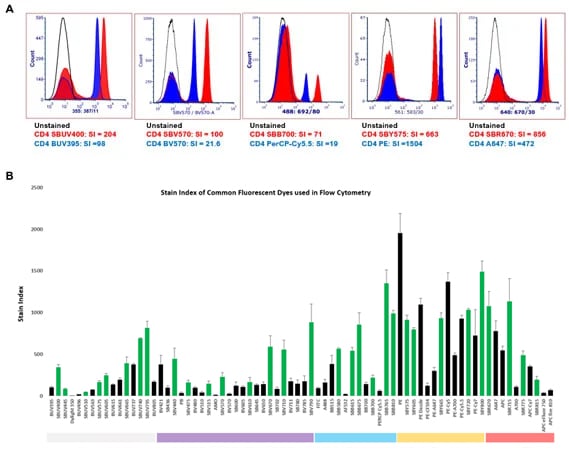

Fig. 1. StarBright Dyes are designed to be brighter than competitor dyes. A, examples of CD4 staining for 355 nm, 405 nm, 488 nm, 561 nm, and 640 nm excitable StarBright Dyes compared to competitors. B, stain index of human peripheral blood stained with various StarBright, Brilliant Violet, Super Bright, and other common dyes conjugated to CD4 (MCA1267). Data is the average of 3-4 donors generated on the ZE5 Cell Analyzer.
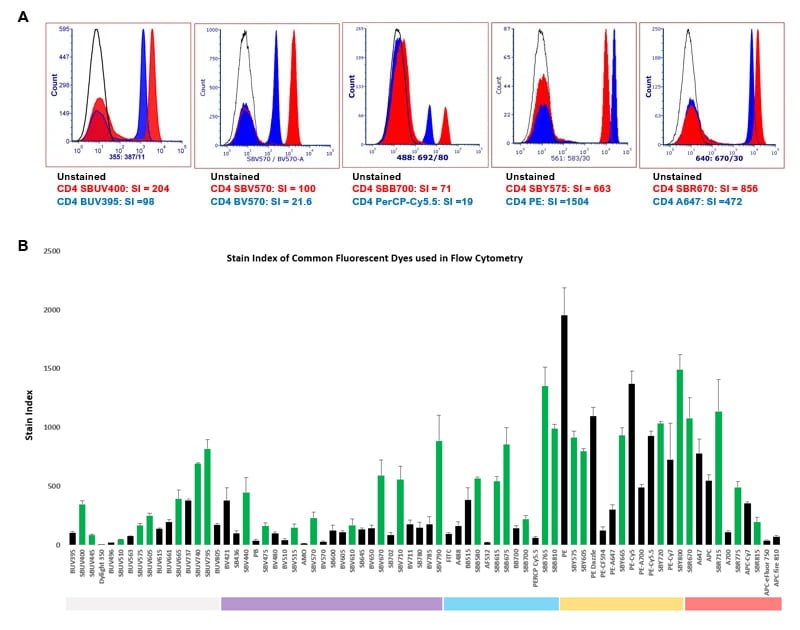
Narrow Excitation and Emission
Reduced excitation by other common laser lines with narrow emission spectra to minimize spillover and spreading make StarBright Dyes an ideal choice for inclusion in multicolor panels. Use our Spectraviewer, which now also includes a spectral analyzer view, to find the right StarBright Dye for your experiment.
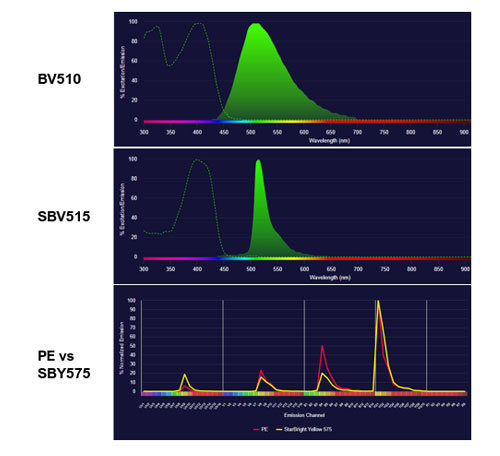

Fig. 2. Examples of improved spectral characteristics of StarBright Dyes. Reduced excitation by the 355 nm laser and narrower emission for StarBright Violet 515 Dye compared to Brilliant Violet 510. Spectral analyzer view showing reduced excitation of StarBright Yellow 575 Dye (yellow) by the 488 nm laser compared with PE (red).
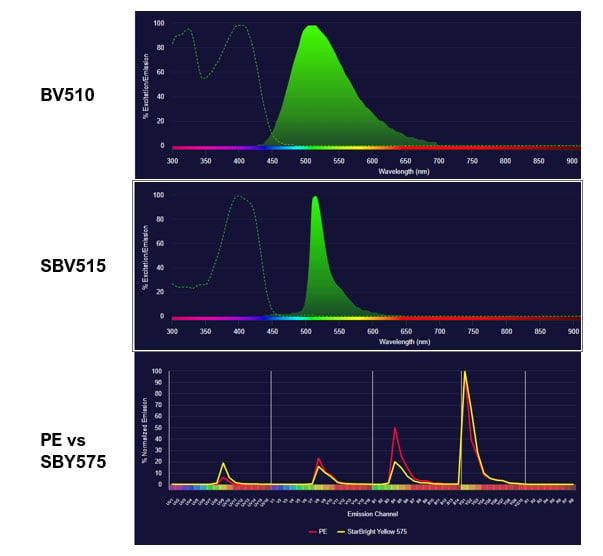
Flexible to Work in All Buffers
StarBright Dyes have no drop in performance regardless of the staining buffer, and do not require a special staining buffer when multiplexing with each other. However, if special buffers are required due to the presence of multiple polymer dyes in your panel, the flexibility of StarBright Dyes means you will still achieve bright, reliable staining.
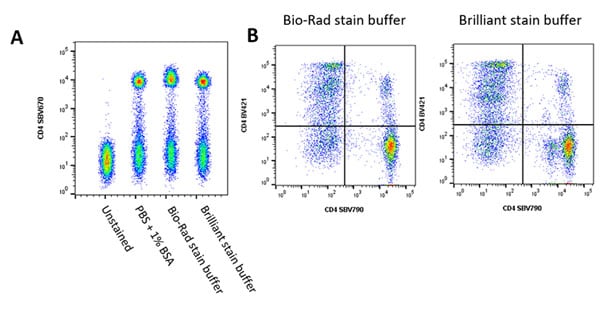

Fig. 3. Examples of staining of human peripheral blood in different buffers. A, no change in CD4 staining (MCA1267SBV670) is observed, regardless of the buffer. B, StarBright Dyes, in this case CD4SBV790 (MCA1267SBV790), work well in both Bio-Rad Staining Buffer or Brilliant Staining Buffer with one Brilliant Violet Dye. Data generated on the ZE5 Cell Analyzer.
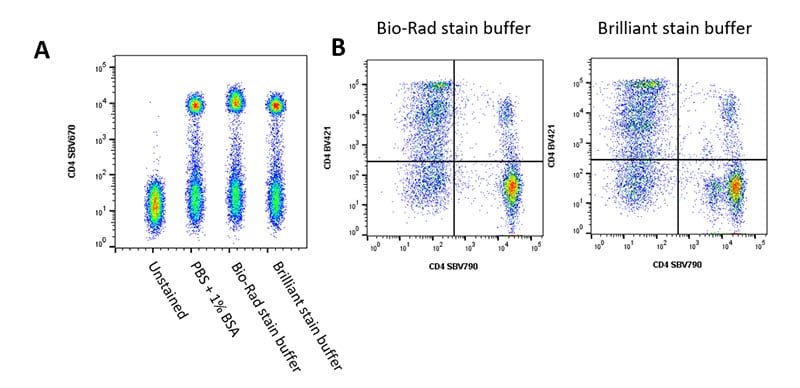
Compatible with All Instruments and Reagents
Designed for multiplexing using the ZE5 Cell Analyzer, StarBright Dyes are suitable for cell analysis or cell sorting on any instrument with the appropriate lasers and filters. StarBright Dyes are compatible with all fluorescently-labeled antibodies and can even be added to premixed cocktails without the need for experimental changes. Furthermore, their unique spectra make them ideal for incorporating into spectral flow cytometry panels with novel dye combinations now possible.
Below are thumbnails of posters which show examples of high parameter panels in conventional and full spectrum flow cytometry. These, along with other useful flow cytometry posters, can be downloaded for your own use.
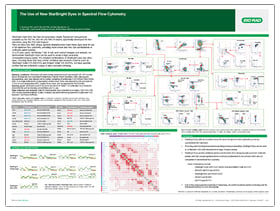
The Use of New StarBright Dyes in Spectral Flow Cytometry
27-color spectral panel built using StarBright Dyes and a spectral flow cytometer.
Consistent Staining
Designed with minimum lot-to-lot variability, StarBright Dyes give the same level of staining and population identification regardless of the batch. Unlike some polymer and other dyes, they are not traditional tandem dyes and therefore exhibit less cross-laser excitation, emitted by the donor and acceptors in tandem dyes, due to insufficient FRET. They are resistant to photobleaching, stable without loss of performance over time, and can be fixed in paraformaldehyde or alcohol-based fixatives with no drop in signal or change in their spectral characteristics. Conveniently, they can even be premixed and stored at 4oC for up to six months without loss of performance for use at a later date. To help you get consistently reproducible results, refer to the StarBright Dyes staining protocol.
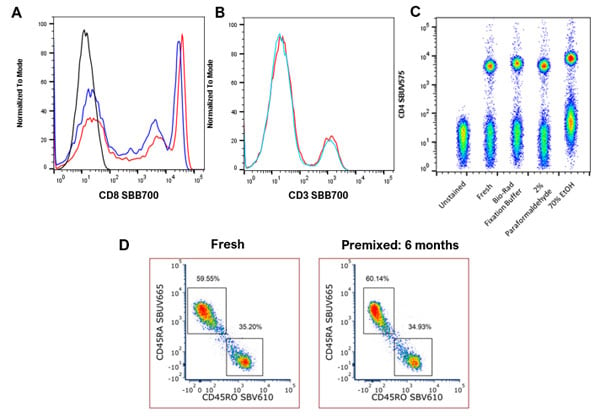

Fig. 4. StarBright Dyes — consistent, stable, fixable, and premixable. StarBright Dyes show consistent results regardless of the lot. A, multiple batches were used to stain peripheral blood mononuclear cells with CD8SBB700 (MCA1226SBB700), and the results overlaid on a histogram. B, stability and within-lot reproducibility confirmed by staining murine peripheral blood with CD3SBB700 (MCA500SBB700) from two different vials of the same lot, one of which was freshly opened and the other opened and stored for over 15 months at 4ºC. C, fixation in Bio-Rad Fixation Buffer, 2% PFA in PBS or 70% EtOH does not result in loss of signal. D, comparison of staining of human blood with a fresh or premixed StarBright Dye panel stored at 4ºC for up to six months. Data generated on the ZE5 Cell Analyzer.
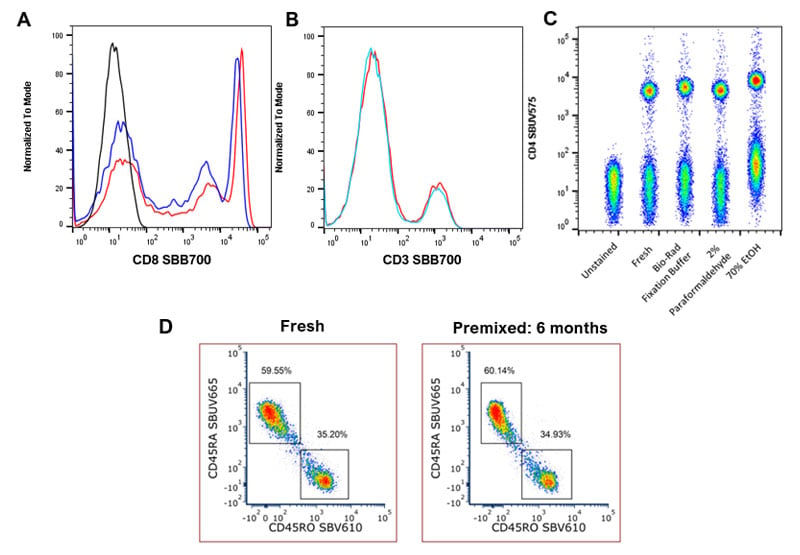
On Common Immunophenotyping Targets
StarBright Dyes are available directly conjugated to antibodies validated for flow cytometry to detect human and mouse targets, and streptavidin for binding to biotinylated antibodies. These antibodies are well-known clones which are highly cited, giving you confidence in your experiments.
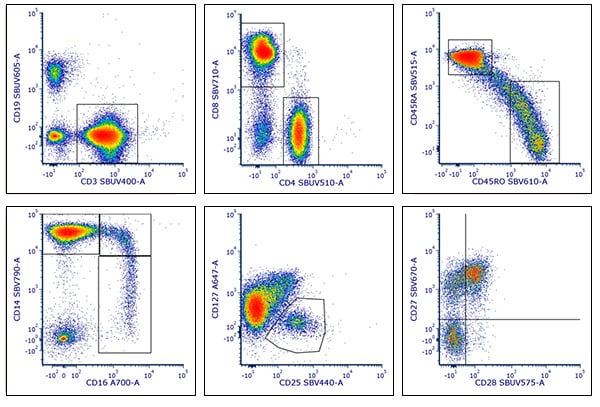

Fig. 5. Examples of staining of common immunophenotyping markers using StarBright Dyes. Human peripheral blood was stained for CD3 (MCA463SBUV400), CD19 (MCA1940SBUV605), CD4 (MCA1267SBUV510), CD8 (MCA1226SBV710), CD25 (MCA2127SBV440), and CD127 (HCA145A647) to identify B and T lymphocytes and T helper, T cytotoxic cells, and T regulatory cells within the T cell population. Classical, intermediate, and nonclassical monocytes were identified using CD14 (MCA16568SBV790) and CD16 (MCA2537A700). Further characterization of the T helper cells was obtained from CD45RA (MCA88SBV515) and CD45RO (MCA461SBV610) to identify naïve and memory cells, and the co-stimulation marker expression on T regulatory cells was measured by CD27 (MCA755SBV670) and CD28 (MCA709SBUV575) levels. Data generated on the ZE5 Cell Analyzer.
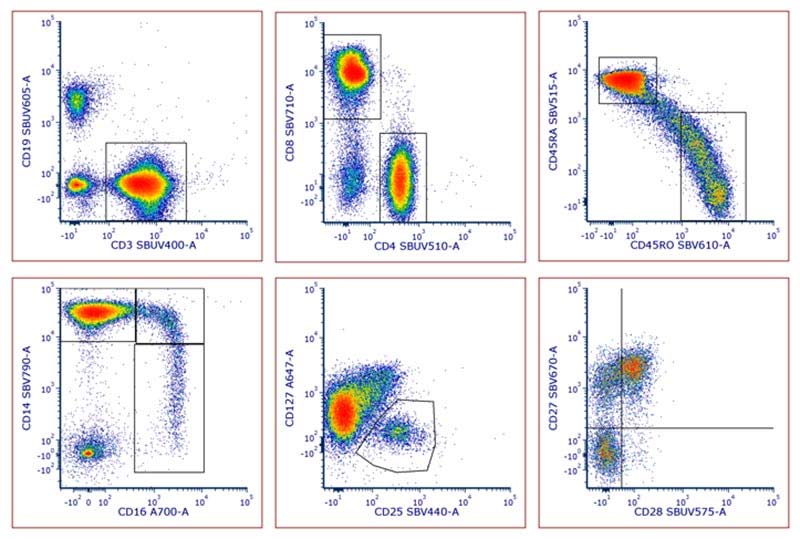
Useful StarBright Dye Information
New
Top Products
Popular Resources
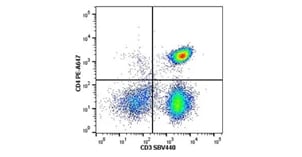
CD4 antibody | RPA-T4
Mouse Anti-Human CD4 clone RPA-T4 detects the surface glycoprotein human CD4 primarily expressed on T helper lymphocytes, T regulatory lymphocytes, peripheral blood monocytes, and tissue macrophages. Conjugated to all StarBright Dyes, CD4 is ideal for calculating and comparing stain indices between fluorescent dyes.

StarBright Dyes — Sample Sizes Now Available
To give you as much flexibility as possible, rather than purchasing pre-planned panels of fluorescent dyes, any sample size of StarBright Dye conjugated CD4 can be purchased individually. A discount is available when buying multiple vials of sample size, increasing when you purchase more.
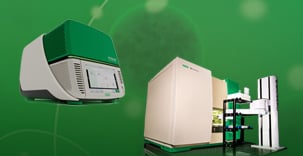
Webinar: How to Automate Flow Cytometry and Real-Time PCR with PAA
In this webinar with a leading automation provider, Peak Analysis and Automation Ltd (PAA), we will discuss automating FC and real-time PCR with the ZE5 Cell Analyzer and CFX Opus. Find out how automation could accelerate your research.
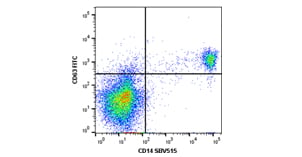
CD14SBV515 antibody | TÜK4
Mouse Anti-Human CD14 recognizes the human cell surface antigen CD14 which functions as a pattern recognition receptor in innate immunity for a variety of ligands. It is strongly expressed on the surface of monocytes and macrophages but has also been shown to be expressed on the surface of non-myeloid cells.

